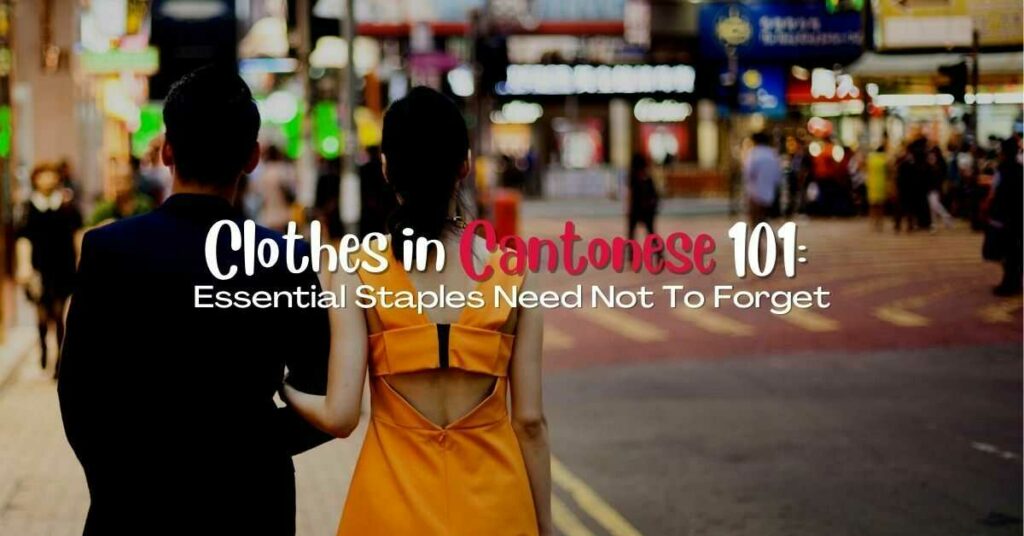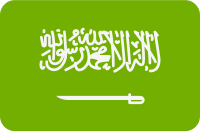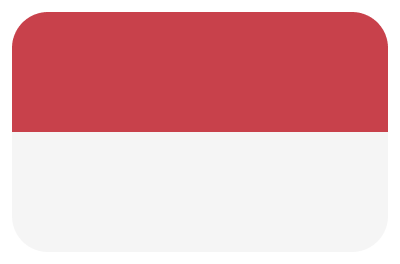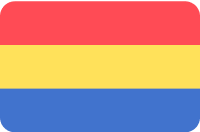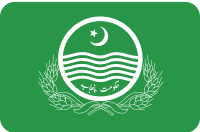Channeling the East-meets-West style is what Hongkongers fashion is all about. So, let’s learn some words about Clothes in Cantonese 衣服 (ji1 fuk6).
Suppose you ride a time machine back to the fashion history of Hong Kong. In that case, you will discover that before China became the big manufacturing country that it is today, the world explores Hong Kong to look for talented designers and tailors to help them develop and promote their labels and brands. This results in the cultural mixing of western and eastern countries. Hong Kong had been their gateway to other Asian countries.
The “Godfather of HK fashion,” Raymond Au, once said, “We had mass manufacturing companies like Lai Sun and Jan See Mee.” This emerged from the history of Hong Kong when it started to focus on business after the war in the 1950s. The British Commonwealth offered preferential tariffs to Hong Kong, which led to the cheap importing of goods from Hong Kong. Refugees from mainland China brought the textile, knowledge, tailoring skills, and capital. With these events combined together, there’s no doubt that Hong Kong had naturally become an ideal and perfect spot for the manufacturing industry.
Brief History Of Hong Kong’s Fashion Evolution
The 60s
- Fashion buyers from all over the world began to flock to buy materials and make orders for finished designs.
- Womenswear began to adopt more masculine shapes, and Jackie Chan began to play lead parts in major films.
- First-ever ready-to-wear festival (Hong Kong Trade Development Council (HKTDC) & Hong Kong Chamber of Commerce)
- People began to get interested in fashion design.
The 70s
- Local pop culture inspires local style
- The HKTDC is taking a huge step to promote local designers
- Sisters (Hong Kong’s first fashion lifestyle magazines) was established
- Hong Kong Polytechnic University was founded, broadening the options for fashion students to study design.
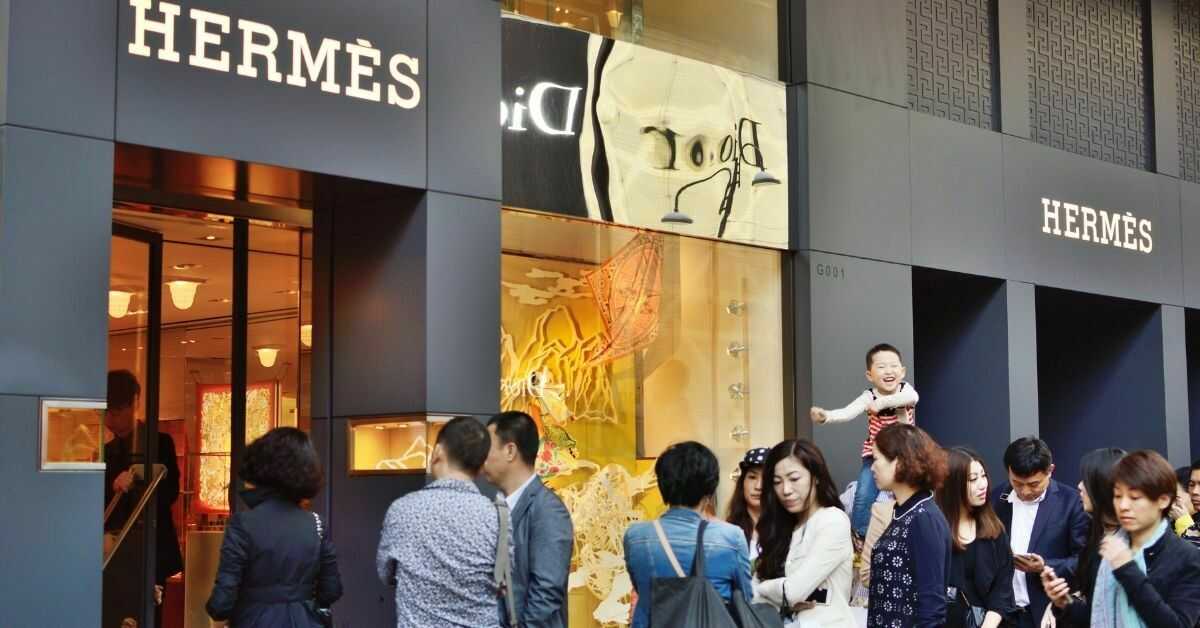
The 80s
- Hong Kong fashion’s ‘Golden Era.’
- Manufacturers were no longer limited to making low- to mid-priced goods; they were now producing high-end fashion.
- Hong Kong was the world’s leading exporter of garments
- Fashion consumption and manufacturing were at an all-time high
- Fashion editorials started
- Hong Kong’s expansion drew the attention of luxury brands, and names such as Chanel and Jean Paul-Gaultier joined the market.
- Opening of The Landmark and LVMH
The 90s
- Age of exclusivity
- The main target market for international luxury companies was socialites.
- Luxury brands like Chanel were very exclusive; they would never lend clothes to a celebrity for an editorial
- Prominent impact of US’ loose-fitting clothing and casual wear
- Comfort is the key
- Local designers were compelled to close their stores when rent prices rose, forcing many to return to work for corporations.
Hong Kongers Fashion Icon And Designers
There are many notable people in the Hong Kong fashion world that you might also want to know. Let’s first discover some notable fashion icons in the different eras.
- Connie Chan Po-chu (the 60s) – “Mod Look”; pastel and polka dot dress with headbands.
- Josephine Siu Fong-fong as Lam Ah-chun (the 70s) – “Ready-to-wear”; slim-waist dresses, hot pants, plaid shirts, collar jackets, bell-bottoms, leggings, and big shawls.
- Leslie Cheung and Anita Mui (the 80’s) – Leslie Chung – Japanese-inspired suits, baggy trousers, jeans, and tank top; Anita Mui – Masculine padded- shoulder look
- Faye Wong (The 90s) – Flowy grunge outfits
Now let’s move to the game-changer designers that really marked Hong Kong’s fashion history:
- Joyce Ma – responsible for introducing edgier, avant-garde labels like Issey Miyake, Yohji Yamamoto, and John Galliano to Hong Kong and high-end luxury names like Giorgio Armani and Prada.
- Phyllis Chan and Suzzie Chung – Owner of YanYan brand, which designs celebrate uniqueness and is influenced by New York, but with a nod to the creators’ Hong Kong roots,
- Anaïs Mak- Founder of Anaïs Jourden,debuted on the runway at Paris Fashion Week last 2019 and received international acclaim.
- Robert Wun – In recent years, Solange, Lady Gaga, Cardi B, and Erykah Badu have praised his work, which has been nominated for the Woolmark Prize and commissioned by the Royal Ballet.
How To Say Clothes In Cantonese?
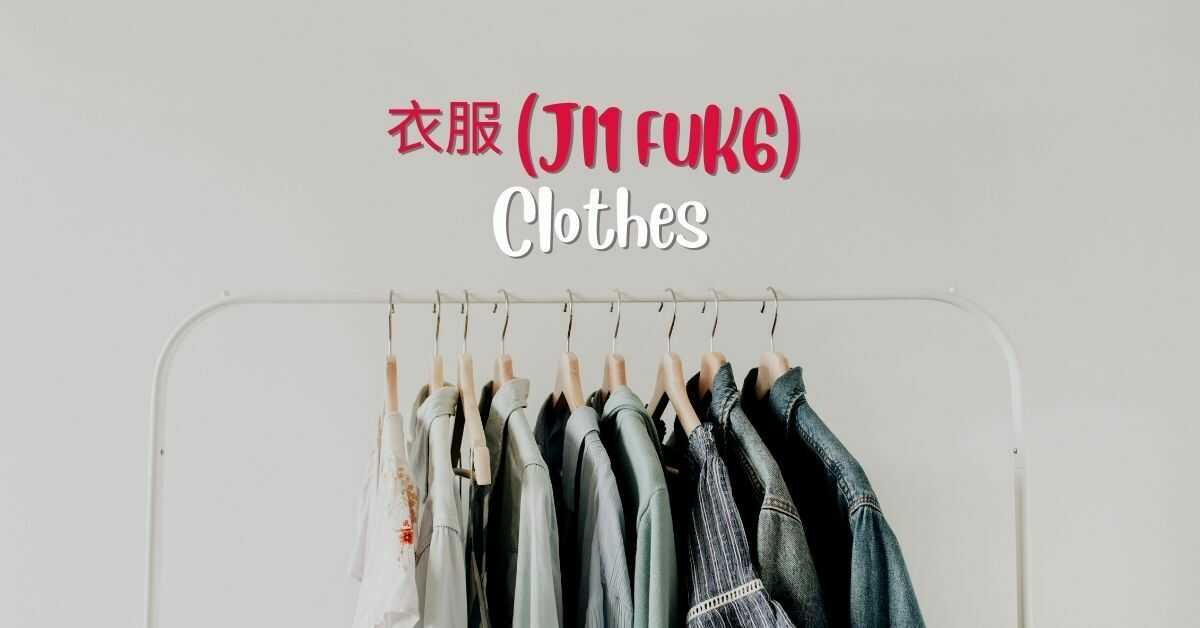
You would definitely agree to start this lesson by learning the basic words about clothes. So, let’s start by learning how to say To Put On / To Wear Clothes, To Take Off and of course, Clothes in Cantonese
衣服 (ji1 fuk6) – Clothes
The Cantonese word for clothes is 衣服 (ji1 fuk6). Beware because you might also encounter the word 衣服 (yīfú). Although these two words kinda sound and look identical to each other, they are different. The word 衣服 (yīfú) is a Mandarin Chinese term.
In both Cantonese and Mandarin language, the pronunciation and tones affect the meaning of a certain word. But remember, Mandarin Chinese and Cantonese Chinese are different. They differ in where they are spoken, the number of tones, and of course, words and phrases. If you want to know more information about their differences, your next lesson can be the difference between Mandarin and Cantonese.
著 (Jeuk3) – To Put On / To Wear Clothes
The next phrase we will learn is 著 (Jeuk3), which means “to put on” in English. There’s only one character to remember so that it won’t be hard for beginners.
除 (Cheui4) – To Take Off
Of course, we should also learn how to say “To take off” in Cantonese. Native speakers use 除 (Cheui4) to say this phrase. This is part of our everyday routine. It will also be helpful when you shop clothes at the luxury brand stores and local shops in Hong Kong.
Fashion Tips
In fashion, there’s a lot of hidden categories and treasure to discover. Everyone has a fashion choice but, you must first understand the rules of fashion before breaking them. It is no doubt that the way people dress really matters. Every country in the world has its own traditional clothes which represent its culture and identity. If you’re going to another country, the way that locals dress should be considered.
Tips For Men’s Clothing In Hong Kong
If you’re a man, here’s a quick list of fashion tips for you:
- Using leopard-print clothes is a no.
- Worried about perspiring, bring an extra shirt. Do not use white singlets should not be worn.
- Don’t go overboard with the stripes, and pay attention to the size of the stripes.
- Pay attention to your trouser length.
- Shoes and belts should go together.
- Do not use murse.
- White socks won’t work.
- Do not use chunky white sports shoes (unless you’re playing).
- Stay neat. Wear deodorant and address the dandruff problem.
Tips For Women’s Clothing In Hong Kong
Women’s fashion is more complicated than men’s. So, for a woman who will visit Hong Kong, hers are some tips to consider:
- Wear clothing that is appropriate for your body type.
- Monograms shouldn’t be on your go-to list.
- Dress according to your age.
- Keep it balanced. Make sure you’re not showing too much skin for both the upper and lower bodies.
- Trousers that are too long, as well as dresses that are too long, are both bad ideas.
- Wearing too-long shirts with leggings is not a good idea.
- Tights, leggings, and trousers are different clothing pieces.
- Only use a bold-colored bra to make a statement when it’s suitable.
- Buy shoes that fit. Not too small or too big either.
- Go for a pedicure if you’re planning to wear open-toe shoes.
- Wearing noisy clothing or accessories is not a good idea.
- Do not use multi-colored hair ties.
- Do not overdo animal print.
- Humidity can mess with your hair, so consider wearing accessories or a scarf to keep it appearing tidy.
- A pashmina is a versatile garment that can be used to spice up any outfit as well as keep you warm or cover your shoulders for modesty.
What To Wear? : Basic Clothes Vocab In Cantonese
It is no surprise that Hong Kong is on your bucket list of countries to visit. What’s not to love in Hong Kong? With beautiful tourist spots, career opportunities, and amazing culture, you will surely have fun and fall in love with this country. But, you really have to consider the season when you’re going to visit to know which clothes to wear or pack.
So, let’s learn different words and phrases related to clothes in Cantonese in terms of seasons:
Summer Clothes In Cantonese
Summer in Hong Kong is extremely hot and humid. The summer season in Hong Kong begins in late May to mid-September, while the Monsoon season is from June to August. Because of this temperature, make sure to wear clothing that will keep you cool but also consider protecting your skin from the sun. Here are some basic summer must-wear clothes in Cantonese:
| Cantonese | Jyutping | English Translation |
| T裇 | ti1 seot1 | t-shirt |
| 絲襪 | si1 mat6 | tights |
| 帽 | mou2 | hat |
| 拖鞋 | to1 haai2 | slipper |
| 懶佬鞋 | laan5 lou2 haai4 | slip-on shoes |
| 雨衣 | jyu5 ji1 | raincoat |
| 遮 | ze1 | an umbrella |
| 太陽眼鏡 | taai3 joeng4 ngaan5 geng3 | sunglasses |
| 泳衣 | wing6 ji1 | swimsuit |
Winter Clothes In Cantonese
If you come from a tropical country like the Philippines, experiencing the winter season is a big deal for you. If you’re not used to low temperatures, make sure to bring with you clothes that will keep you warm because the winter breeze is not a joke. Winter in Hong Kong comes in December and ends in February. If you don’t have clothes for this season, don’t worry because a lot of shopping centers and malls in Hong Kong are on sale since it’s the Holiday season:
So, here are some basic winter clothes that you need to know:
| Cantonese | Jyutping | English Translation |
| 長袖 | coeng4 zau6 | long-sleeved |
| 汗衣 | hon6 ji1 | sweatsuit |
| 外套 | ngoi6 tou3 | jacket |
| 沉重的外套 | cam4 cung5 dik1 ngoi6 tou3 | heavy jacket |
| 大褸 | daai6 lau1 | overcoat/coat |
| 冬天大褸 | dung1 tin1 daai6 lau1 | winter coat |
| 牛仔褲 | ngau4 zai2 fu3 | jeans |
| 長褲 | coeng4 fu3 | trousers |
| 靴 | hoe1 | boots |
| 手套 | sau2 tou3 | gloves |
| 圍巾 | wai4 gan1 | scarf |
Spring Clothes In Cantonese
The spring season begins from March to mid-May. During the spring season in Hong Kong, the weather is warm, wet, and unstable. So, you should really check the forecast before going on a trip so that you’ll wear appropriate clothes to make you feel comfortable. Here’s a list of some spring clothes in Cantonese:
| Cantonese | Jyutping | English Translation |
| 短袖T恤 | yun2 zau6 ti1 seot1 | short-sleeved t-shirt |
| 冷外套 | laang5 ngoi6 tou3 | cardigan |
| 套頭衫 | tou3 tau4 saam1 | pullover |
| 褲 | fu3 | pants |
| 運動鞋 | wan6 dung6 haai4 | sneakers |
| 短袖 | dyun2 zau6 | short-sleeved |
Autumn Clothes In Cantonese
The autumn season is the best time for traveling because the sun is waving and the weather is pleasant. You can definitely rock your OOTD when you go to Hong Kong during this season. Here are some autumn clothes in Cantonese that you might want to pack:
| Cantonese | Jyutping | English Translation |
| 短褲 | dyun2 fu3 | shorts |
| 恤衫 | seut1 saam1 | shirts |
| 裙 | kwan4 | skirt |
| 迷你裙 | mai4 nei5 kwan4 | mini-skirt |
| 恤衫 | seot1 saam1 | blouse |
| 涼鞋 | loeng4 haai4 | sandals |
| 鞋 | haai4 | shoes |
More Vocabulary Related To Clothes In Cantonese
After learning some basic accessories and clothes in Cantonese, let’s widen our vocabulary with these additional words.
Clothes And Parts
| Cantonese | Jyutping | English Translation |
| 裙 | kwan4 | dress |
| 背心 | bui3 sam1 | vest |
| 西裝 | sai1 zong1 | suit |
| 長袍 | coeng4 pou4 | robe |
| 睡衣 | seoi6 ji1 | pajamas |
| POLO恤 | pou1 lou1 seot1 | polo shirt |
| 兜帽 | dau1 mou6 | hood |
| 口袋 | hau2 doi6 | |
| 鈕 | nau2 | button |
Undergarments
| Cantonese | Jyutping | English Translation |
| 胸罩 | hung1 zaau3 | bra |
| 女裝內褲 | neoi5 zong1 noi6 fu3 | panties |
| 孖煙筒 | maa1 jin1 tung1 | boxer shorts |
| 內褲 | noi6 fu3 | underpants |
Shoes And Accessories
| Cantonese | Jyutping | English Translation |
| 襪 | mat6 | socks |
| 領呔 | leng5 taai1 | tie |
| 披肩 | pei1 gin1 | shawl |
| 高踭鞋 | gou1 zaang1 haai4 | high heels |
| 波鞋 | bo1 haai4 | sport shoes |
| 皮帶 | pei4 daai3 | belt |
| 眼鏡 | ngaan5 geng3 | glasses |
| 手錶 | sau2 biu1 | wristwatch |
| 耳環 | ji5 waan4 | earrings |
| 頸鏈 | geng2 lin2 | necklace |
Additional Terms
| Cantonese | Jyutping | English Translation |
| 布 | bou3 | cloth |
| 衣服 | ji1 fuk6 | clothing |
| 尺碼 | chek3 ma5 | size |
| 長 | cheung4 | long |
| 短 | dyun2 | short |
| 貴 | gwai3 | expensive |
| 平 | peng4 | cheap |
| 款式 | fun2 sik1 | style |
| 流行 | lau4 hang4 | fashionable |
| 設計師 | cit3 gai3 si1 | designer |
| 時裝店 | si4 zong1 dim3 | clothing store |
| 服裝 | fuk6 zong1 | clothing |
| 污糟衫 | wu1 zou1 saam1 | laundry |
Phrases And Sentences
| Cantonese | Jyutping | English Translation |
| 打折 | da2 jit3 | to discount |
| 洗衫 | sai2 saam1 | to wash clothing; to do laundry |
| 試 | si3 | to try |
| 啱身 | ngaam1 san1 | to fit |
| 稱身 | cing3 san1 | fit a garment |
| 著幾層衫 | zoek3 gei2 cang4 saam1 | layers of clothing |
| 換衫 | wun6 saam1 | change clothes |
| 保暖嘅衫 | bou2 nyun5 ge3 saam1 | warm clothes |
| 我打扮 | ngo5 daa2 baan6 | I get dressed |
| 我摺 | ngo5 zip3 | I fold |
| 我掛起 | ngo5 gwaa3 hei2 | I hang up |
| 我脫下褲子。 | ngo5 tyut3 haa6 fu3 zi2. | I took off my pants. |
| 我 着 咗 一 件 恤 衫。 | ngo5 jeuk3 jo2 yat1 gin6 seut1 saam1。 | I put on a shirt. |
| 我 想 要 呢 件 恤 衫。 | ngo5 seung2 yiu3 ni1 gin6 seut1 saam1。 | I would like to have a shirt. |
| 你著得好好睇 | nei5 zyu3 dak1 hou2 hou2 tai2 | It looks good on you. |
| 呢 件 恤 衫 有 三 個 尺 碼。 | ni1 gin6 seut1 saam1 yau5 saam1 go3 chek3 ma5。 | This shirt comes in three sizes. |
Suit Up For An Amazing Language Learning Experience
Dressing up is not enough to channel the inner Hong Konger in you. It’s time for you to level up your language skills and learn Cantonese. So, congratulations on reaching this far and suit up for an amazing learning experience with Ling App.
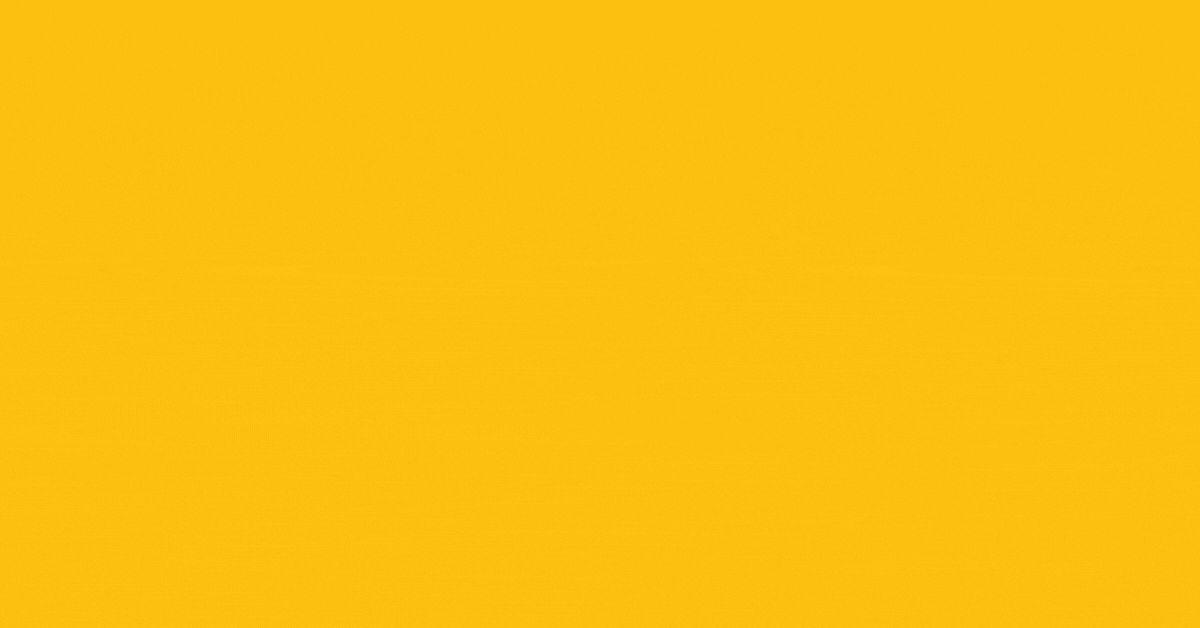
With Ling App, you’ll have access to lots of topics and lessons. These topics are arranged in a flashcard-like form. Each flashcard contains the word or phrase, including images and audio recordings to ensure the quality of knowledge and skills that you are learning. With Ling App, learning is designed in a game-like way so that learning will be engaging, challenging, and motivating. What’s more interesting is Ling App uses spaced repetition system which is a proven approach in learning languages.
Don’t miss the amazing opportunity to learn Cantonese for free. Go to Ling App site or download it in App Store or Google Store. Start learning Cantonese now!
